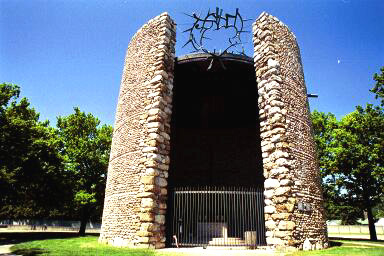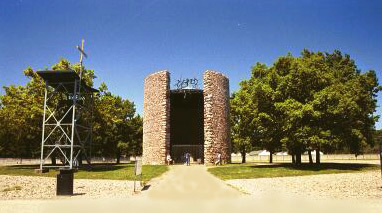Church of the Mortal Agony of Christ Many first-time visitors to the former Dachau concentration camp are shocked, as I was, to find that the most prominent spot in the present-day Memorial Site is occupied by a Catholic Church. Since the first news reports about Dachau at the end of April 1945, the concentration camp has always been associated, in the minds of most people, with the death of 6 million Jews in the Holocaust. On my four visits to the Dachau Memorial Site, I overheard many people commenting that they didn't think it was appropriate to have Christian memorials at the site where so many Jews had suffered and died. Actually, the majority of the prisoners at Dachau were Catholic, including many Polish, Italian and French inmates. They were not sent to Dachau because of their religious beliefs, but because they were anti-Nazi resistance fighters. When the American liberators arrived at Dachau on April 29, 1945, the majority of the prisoners in the camp were Polish Catholics. According to the US Army census, there were 2,539 Jews in the camp, most of them having arrived in the last days and weeks of the war, after being evacuated from other camps. After 1940, all the Catholic priests, who had been imprisoned by the Nazis for resistance activities, were consolidated at the Dachau camp. A total of 2,579 Catholic clergymen were among the inmates at Dachau, including many anti-Nazi priests brought from Poland. Although the Catholic Church itself was not officially opposed to Hitler, himself a non-practicing Catholic, the majority of the prisoners who died in the Dachau camp were Roman Catholic. The name of the Catholic chapel is Todeangst Christi. It is usually translated as Mortal Agony of Christ in English, although the literal translation of the German title would be Christ's Mortal Fear or Anxiety. The church was built in 1960 at the instigation of Dr. Johannes Neuhäusler, a former inmate of the camp who became a Bishop in Munich after the war. Neuhäusler was arrested in 1941 for breaking one of the laws of the Nazi government by publicly reading the critical writings of Cardinal Faulhaber, who opposed the Nazi regime. He was first taken to the Sachsenhausen concentration camp near Berlin and then transferred to Dachau a few months later. The Church of the Mortal Agony of Christ, designed by German architect Josef Wiedemann, stands on a circular island of grass surrounded by a ring of oak trees. It is 14 meters high and the base is 14 meters in diameter. The entrance features a wrought iron gate which was locked when I was there. The interior is exposed to the elements through a front opening that is the same height as the interior of the building. The circular wall was constructed of reinforced concrete and then covered on both sides with a veneer of river rocks, taken from the nearby Isar river. Construction required only four months to complete. After the Catholic memorial was completed, Dr. Neuhäusler generously suggested that a Protestant Memorial and a Jewish Memorial should be built on either side of the Catholic one. He proposed a Memorial Site layout with trees planted in between the old barracks and lush green landscaping surrounding all the religious memorials, but the architects of the Jewish and Protestant memorials preferred to have their buildings isolated in a sea of coarse gravel. The photograph below shows a view of the west side of the Jewish Memorial taken from the cool shade of one of the beautiful oak trees surrounding the Catholic chapel.  An estimated 60,000 persons attended the dedication of the Catholic church on August 5, 1960 on the occasion of a meeting of the Eucharistic World Congress. At that time, the Dachau camp had not yet been totally converted into a Memorial Site and the 34 wooden barracks buildings on either side of the main camp road in front of the church were still standing. The barracks were occupied by German refugees, who had been expelled from their homes in the Sudetenland in what is now the Czech Republic, after the war. At the opening ceremony, the crowd filled the wide camp road, which is a quarter of a mile long and extends to the roll-call square at the south end of the camp, where the International Monument was dedicated 8 years later. The outside of the church does not have the usual Christian cross on top, but instead is adorned with a Crown of Thorns, made of twisted iron bars, as shown in the first photograph below. There is, however, a Christian cross on top of the bell tower donated by the Austrian survivors of Dachau, which stands on the west side of the church, shown in the second photograph below. Professor Josef Wiedemann, who designed the church, also designed the bell tower, which was consecrated on July 22, 1961. The inscription reads "In faithful memory of our dead comrades of all nations, dedicated by the Dachau priests and laymen from Austria."    The plaque on the rear of the Church, shown in the photograph above, was donated by Polish priests who were survivors of the camp; it was dedicated on August 19, 1972. It has inscriptions in memory of the Polish Catholics who died in the camp. The interior of the Catholic church has a small altar on a raised platform. Suspended from the ceiling above the altar is a huge Christian cross (not shown) which looks more like a giant plus sign. The photograph below shows the altar, taken by placing the camera between the iron bars of the locked gate.  The Catholic ConventBack to Memorial SiteBack to Table of ContentsHomeThis page was last updated on August 4, 2009 |